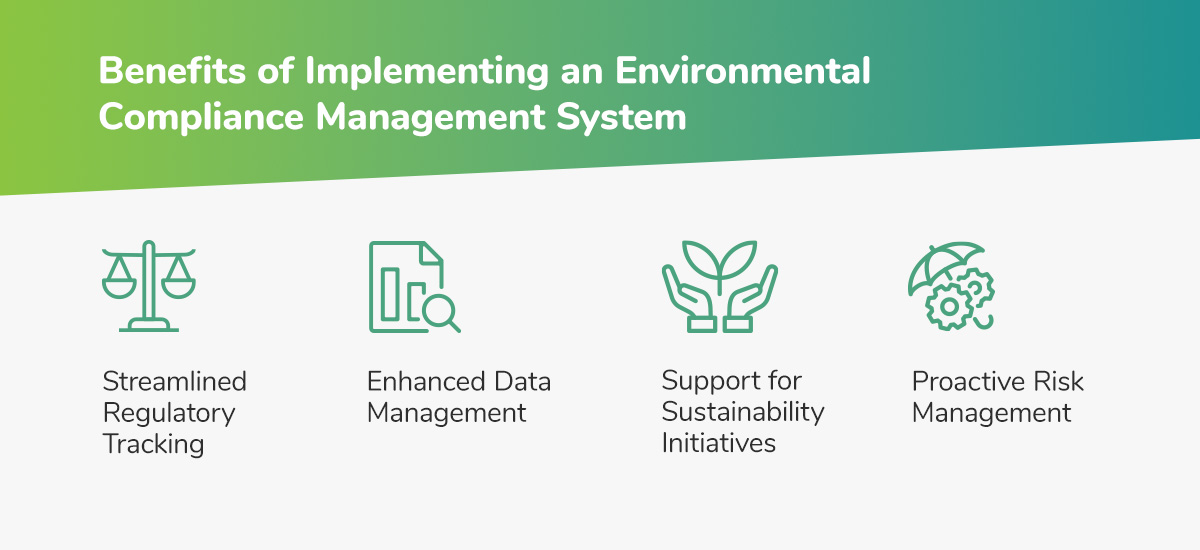Environmental Compliance Challenges in Manufacturing
For manufacturing companies, environmental compliance is a critical responsibility — one that grows more complex with every new regulation and expectation. As an environmental director or manager, you face daily challenges in navigating evolving mandates, coordinating compliance across facilities, and ensuring your organization avoids costly missteps. Beyond compliance itself, the stakes include operational efficiency, risk management, and maintaining a strong reputation.
The reality is that managing environmental compliance isn’t just about checking boxes. It’s about staying ahead of audits, avoiding penalties, and preventing disruptions that can ripple through your operations. To meet these demands, you need a system that goes beyond tracking deadlines by providing actionable insights and integrates seamlessly with your team’s workflow. That’s where an environmental compliance management system like PlanTRAK can make all the difference.
Understanding Environmental Compliance in Manufacturing
In today’s manufacturing landscape, environmental compliance is more than a legal obligation — it’s a critical operational priority. From mitigating regulatory risk to streamlining operations, staying compliant with environmental laws ensures manufacturers can operate efficiently while protecting natural resources and public health. However, the path to compliance can be fraught with challenges, particularly as regulations evolve and expand.
Key regulations that manufacturers must navigate include:
- Emergency Planning and Community Right-to-Know Act (EPCRA): The EPCRA helps local communities stay safe from environmental hazards by outlining how they should plan for emergencies, provide information on chemicals stored within their bounds, and report chemical releases.
- Superfund Amendments and Reauthorization Act (SARA): SARA mandates that any facility using, storing, or manufacturing hazardous chemicals shares its inventory with the public and reports every release of hazardous chemicals.
- State and local regulations: While federal regulations set the standard for environmental compliance, manufacturers must be aware of any state or local regulations that apply to or supersede federal requirements.
- ISO 14001 certification: ISO 14001 is a globally recognized standard for organizations implementing an EMS. An ISO 14001 certification indicates that a business meets environmental compliance for resource usage, waste management, environmental footprint, and performance.
- Clean Water Act (CWA): The CWA protects public water systems and prioritizes clean water by restricting businesses from polluting the water with waste.
- Clean Air Act (CAA): The EPA helps address air quality and pollution with the CAA, a federal law that regulates air emissions to address emissions of hazardous air pollutants.
- Toxic Substances Control Act (TSCA): Under the TSCA of 1976, the EPA has the authority to regulate chemicals and substances that could harm public health and the environment. The EPA also requires reporting, testing, and restrictions regarding the production, use, and importation of these chemicals and substances.
- Resource Conservation and Recovery Act (RCRA): The RCRA of 1976 regulates how hazardous waste is generated, stored, transported, disposed of, and managed in manufacturing and production companies. For example, the RCRA prioritizes the minimization of land disposal.
The Role of Compliance in Sustainable Manufacturing Practices
Manufacturing compliance has never been more important when it comes to environmental sustainability. Manufacturing processes and products must meet established requirements, laws, regulations, and quality control standards set by regulatory bodies to reduce emissions, minimize waste, and promote sustainable materials and practices.
Compliance in manufacturing also helps ensure products are safe for employees and consumers. Sustainable manufacturing practices contribute to a reduced risk of fines and penalties for noncompliance, which can improve operational efficiency and brand reputation.
Common Environmental Compliance Challenges
Let’s take a look at some of the most common obstacles that manufacturing businesses face today.
1. Regulatory Complexity
Laws and regulations are ever-changing in the manufacturing and production industries. As a result, many organizations may find it difficult to keep up with these frequent updates to meet evolving environmental needs. It’s critical for companies to stay on top of shifting compliance requirements from environmental agencies and adapt their plans, though the variability across regions and countries adds to this complexity.
Some organizations also lack the time and resources to implement adjustments to accommodate these new regulations. Using environmental management systems and software can help streamline these processes.
2. Resource Constraints
Another challenge that manufacturing organizations face is the limited financial and employee resources to accomplish compliance initiatives. For example, insufficient staff training and expertise can prevent the successful adoption of best practices. Without the resources necessary to prioritize environmental compliance activities, manufacturing businesses may find it challenging to improve environmental compliance performance.
3. Data Management Issues
Every industry and state has different reporting requirements, so data collection and organization can be challenging to standardize. Organizations striving for environmental compliance can experience difficulty tracking and reporting compliance data with outdated technology. Additionally, a lack of integrated systems for data collection and analysis presents many complex issues for accurately collecting and entering data.
4. Operational Disruptions
Noncompliance incidents can become additional roadblocks in an organization’s path to environmental compliance. These incidents can lead to fines, legal disputes, production halts and delays, revenue loss, and employee turnover. These issues can make meeting environment compliance more difficult as companies must adjust their current operations accordingly.
Benefits of Implementing an Environmental Compliance Management System
Using an environmental compliance management system, you can reap the operational, financial, reputational, and legal benefits of maintaining environmental and manufacturing compliance.

1. Streamlined Regulatory Tracking
Maintaining environmental compliance requires an understanding of where your organization stands. By tracking the state of your staff, resources, and environmental footprint, you can more easily adjust to meet changing environmental laws and standards.
Your environmental compliance management system is a centralized repository for all compliance-related documents, improving accessibility and visibility into your compliance goals.
2. Enhanced Data Management
Gone are the days of logging into separate systems to efficiently manage your day-to-day operations and ensure compliance. With an environmental compliance management system, you can centralize your data and integrate it with existing manufacturing software, such as an enterprise resource planning system or manufacturing execution system. This seamless integration enables access to real-time data for you and your team to effectively oversee environmental compliance and track objectives.
3. Support for Sustainability Initiatives
An environmental compliance management system can help your organization align with your broader sustainability goals. By having direct access to performance data, companies can develop and implement effective strategies for reducing their environmental footprint. Your organization can update the system as needed to reflect any changes in regulations or organizational goals.
4. Proactive Risk Management
Implementing an environmental compliance management system can help you avoid potential compliance issues by enabling you to manage and track your obligations, communicate them to your staff, and ensure nothing slips through the cracks or goes overlooked. An environmental compliance management system is your centralized system to help you identify, evaluate, and mitigate risks that could result in operational disruptions, litigation, fines, or sanctions.
Additionally, proactive risk management with an environmental compliance management system can help you position yourself as a forward-thinking organization that strives for continuous improvement, which can boost your reputation while reducing organizational risk.
How to Choose the Right Environmental Compliance Management System for Your Manufacturing Business
When choosing an environmental compliance management system for your manufacturing business, you should first consider what your organization needs. What are your compliance pain points and objectives? What do your existing environmental compliance processes look like? Once you’ve assessed your needs and priorities, consider some key features that can help your business remain in compliance:
- Industry and business specialization
- Scalability to meet your complex needs
- Reporting tools and features
- Risk assessment and management features
- Real-time monitoring of compliance activities
- Integration capabilities and supported platforms
- Detailed and customized reporting
- User access management
- Real-time alerts for data changes
- Data classifications
- Mobile device support
- Auditing capabilities
Before you select the right compliance software, be sure to shop around to various potential vendors. Ask yourself questions to determine if a compliance management solution meets your needs, such as:
- What additional features does it offer outside of compliance?
- How can I track my compliance activities?
- Is this solution specifically designed for manufacturing business needs?
- How well does it integrate with my existing software?
- What areas of compliance does it address
Overcome Environmental Compliance Challenges With PlanTRAK
Environmental compliance can be complex, particularly with the constant regulation changes in the manufacturing industry. While there is no magic solution to guarantee environmental compliance, an environmental compliance management system is a powerful tool that can reduce the complexity of regulatory obligations.
PlanTRAK simplifies the process by centralizing compliance management and automating critical tasks, giving manufacturers the tools to succeed in a complex regulatory environment. Whether you’re managing multiple facilities, tracking evolving regulations, or striving for sustainability, PlanTRAK’s robust environmental compliance management system ensures you stay on track while reducing risk and operational overhead.
If you’re interested in reaping the benefits of implementing an environmental compliance management system, we invite you to schedule a demo of PlanTRAK today!

